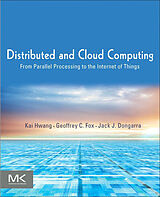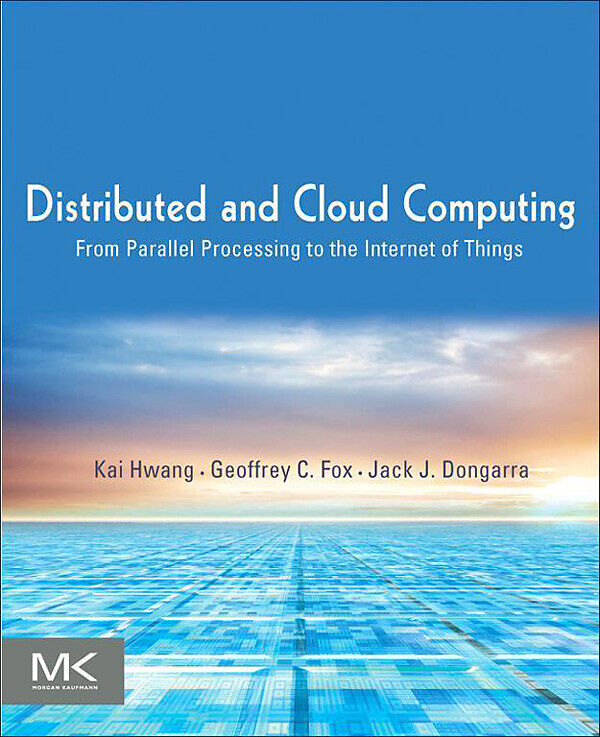Distributed and Cloud Computing
Einband:
E-Book (pdf)
EAN:
9780128002049
Untertitel:
From Parallel Processing to the Internet of Things
Genre:
Informatik, EDV
Autor:
Kai Hwang, Jack Dongarra, Geoffrey C. Fox
Herausgeber:
Elsevier Science & Techn.
Anzahl Seiten:
672
Erscheinungsdatum:
18.12.2013
Distributed and Cloud Computing: From Parallel Processing to the Internet of Things offers complete coverage of modern distributed computing technology including clusters, the grid, service-oriented architecture, massively parallel processors, peer-to-peer networking, and cloud computing. It is the first modern, up-to-date distributed systems textbook; it explains how to create high-performance, scalable, reliable systems, exposing the design principles, architecture, and innovative applications of parallel, distributed, and cloud computing systems. Topics covered by this book include: facilitating management, debugging, migration, and disaster recovery through virtualization; clustered systems for research or ecommerce applications; designing systems as web services; and social networking systems using peer-to-peer computing. The principles of cloud computing are discussed using examples from open-source and commercial applications, along with case studies from the leading distributed computing vendors such as Amazon, Microsoft, and Google. Each chapter includes exercises and further reading, with lecture slides and more available online. This book will be ideal for students taking a distributed systems or distributed computing class, as well as for professional system designers and engineers looking for a reference to the latest distributed technologies including cloud, P2P and grid computing. - Complete coverage of modern distributed computing technology including clusters, the grid, service-oriented architecture, massively parallel processors, peer-to-peer networking, and cloud computing - Includes case studies from the leading distributed computing vendors: Amazon, Microsoft, Google, and more - Explains how to use virtualization to facilitate management, debugging, migration, and disaster recovery - Designed for undergraduate or graduate students taking a distributed systems course-each chapter includes exercises and further reading, with lecture slides and more available online
Autorentext
Kai Hwang is a Professor of Computer Engineering, University of Southern California and an IV-endowed visiting Chair Professor, Tsinghua University, China. He earned the Ph.D. in EECS from University of California at Berkeley. An IEEE Life Fellow, He has published extensively in computer architecture, digital arithmetic, parallel processing, distributed systems, Internet security, and cloud computing. He has founded the Journal of Parallel and Distributed Computing and delivered three dozens of keynote addresses in major IEEE/ACM Conferences. He received the 2004 Outstanding Achievement Award from China Computer Federation and the IEEE 2011 IPDPS Founders' Award for his pioneering contributions in the field of parallel processing.
Inhalt
Part 1: Systems Modeling, Clustering and Virtualization Chapter 1: Distributed System Models and Enabling Technologies 1.1 Scalable Computing Service over The Internet 1.2 Technologies for Network-based Computing 1.3 System Models for Distributed and Cloud Computing 1.4 Software Environments for Distributed Systems and Clouds 1.5 Performance, Security, and Energy-Efficiency 1.6 Bibliographic Notes and Homework Problems Chapter 2: Computer Clusters for Scalable Computing 2.1 Clustering for Massive Parallelism 2.2 Computer Clusters and MPP Architectures 2.3 Design Principles of Computer Clusters 2.4 Cluster Job and Resource Management 2.5 Case Studies of Supercomputyers and MPP Systems 2.6 Bibliographic Notes and Homework Problems Chapter 3: Virtual Machines and Virtualization of Clusters and Datacenters 3.1 Implementation Levels of Virtualization 3.2 Virtualization Structures/Tools and Mechanisms 3.3 Virtualization of CPU, Memory and I/O Devices 3.4 Virtual Clusters and Resource Management 3.5 Virtualization for Datacenter Automation 3.6 Bibliographic Notes and Homework Problems Part 2: Computing Clouds and Service-Oriented Architecture Chapter 4: Design of Cloud Computing Platforms 4.1 Cloud Computing and Service Models 4.2 Datacenter Design and Interconnection Networks 4.3 Architecture Design of Compute and Storage Clouds 4.4 Public Cloud Platforms: GAE, AWS and Windows Azure 4.5 Cloud Resource Management and Exchanges 4.6 Cloud Security and Trust Management 4.7 References and Homework Problems Chapter 5: Service Oriented Architectures 5.1 Services and Service Oriented Architectures 5.2 Message-Oriented Middleware 5.3 Portals and Science Gateways 5.4 Discovery, Registries, Metadata, and Databases 5.5 Workflow in Service-Oriented Architectures 5.6 Bibliographic Notes and Homework Problems Chapter 6: Cloud Programming and Software Environments 6.1 Features of Cloud and Grid Platforms 6.2 Parallel and Distributed Programming Paradigms 6.3 Programming Support of Google App Engine 6.4 Amazon Web Services (AWS) Programming 6.5 Microsoft Azure Programming Support 6.6 Emerging Cloud Software Environments 6.7 Bibliographic Notes and Homework Problems Part 3: Grids, P2P, and The Future Internet Chapter 7: Grid Computing and Resource Management 7.1 Grid Architecture and Service Modeling 7.2 Case Studies of Grid Computing Systems 7.3 Grid Resource Management and Brokering 7.4 Middleware Support for Grid Resource Management 7.5 Grid Security Infrastructure in GT4 7.6 Bibliographic Notes and Homework Problems Chapter 8: P2P Computing with Overlay Networks 8.1 Peer-to-Peer Computing Systems 8.2 P2P Overlay Networks and Properties 8.3 Routing, Proximity and Fault Tolerance 8.4 Trust and Reputation Management 8.5 P2P File Sharing and Copyright Protection 8.6 Bibliographic Notes and Homework Problems Chapter 9: Ubiquitous Computing with Clouds and The Internet of Things 9.1 Cloud Trend To Support Ubiquitous Computing 9.2 Performance Metrics for HPC and HTC Systems 9.3 Enabling Technologies for The Internet of Things 9.4 Innovative Applications of The Internet of Things 9.5 On-Line Social and Professional Networking 9.6 Bibliographic Notes and Homework Problems

Leider konnten wir für diesen Artikel keine Preise ermitteln ...
billigbuch.ch sucht jetzt für Sie die besten Angebote ...
Die aktuellen Verkaufspreise von 6 Onlineshops werden in Realtime abgefragt.
Sie können das gewünschte Produkt anschliessend direkt beim Anbieter Ihrer Wahl bestellen.
Loading...
Die aktuellen Verkaufspreise von 6 Onlineshops werden in Realtime abgefragt.
Sie können das gewünschte Produkt anschliessend direkt beim Anbieter Ihrer Wahl bestellen.
| # | Onlineshop | Preis CHF | Versand CHF | Total CHF | ||
|---|---|---|---|---|---|---|
| 1 | Seller | 0.00 | 0.00 | 0.00 |
